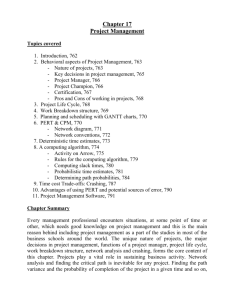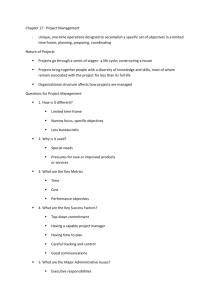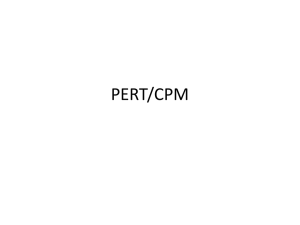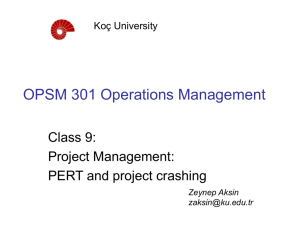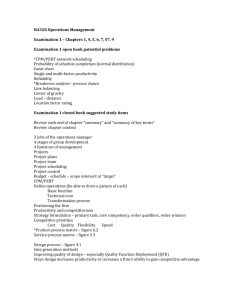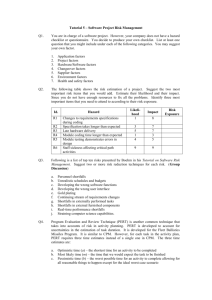the minimum time
advertisement
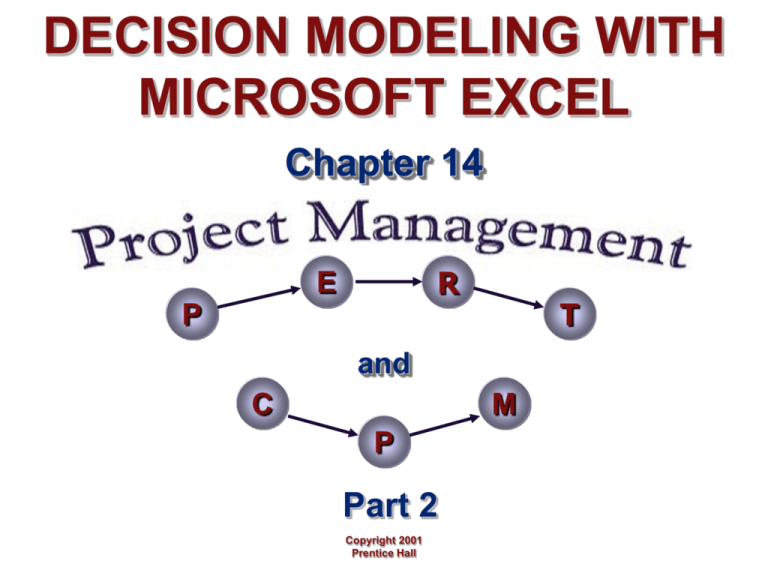
DECISION MODELING WITH
MICROSOFT EXCEL
Chapter 14
R
E
T
P
and
C
M
P
Part 2
Copyright 2001
Prentice Hall
V ARIABILITY IN ACTIVITY TIMES
Now consider the second question raised in the
introduction:
What is the potential “variability” in this date?
So far we have been acting as though the activity
times and the derived values for ES, LS, EF, and LF
were all deterministic.
In reality, the activity times are often not known in
advance with certainty.
PERT employs a special formula for estimating
activity times. In addition, the PERT approach can
be used to calculate the probability that the project
will be completed by any particular time.
ESTIMATING THE EXPECTED ACTIVITY TIME
The PERT system uses three time estimates to
calculate the activity time.
1. Optimistic time (denoted by a): the minimum
time (under perfect circumstances).
2. Most probable time (denoted by m): the most
likely time (under normal circumstances).
3. Pessimistic time (denoted by b): the
maximum time (under “Murphy’s Law”
circumstances).
Note that these time estimates should be provided
by someone who understands the activity in
question very well.
Consider, for example, activity E, construct the
interior. After careful consideration of each phase of
the construction project, the general contractor
arrives at the following estimates:
a=4
m=7
b = 16
The relatively large value for b is caused by the
possibility of a delay in the delivery of the airconditioning unit for the computer.
If this unit is delayed, the entire activity is delayed.
Moreover, in this case, since E is on the critical path,
a delay in this activity will delay the entire project.
In the original development of PERT (during the late
1950s), the procedure for estimating the expected
value of the activity times was motivated by the
assumption that the activity time was a random
variable with a beta probability distribution.
The beta distribution has a minimum and maximum
value and is capable of assuming a wide variety of
shapes.
The expected value of a beta distribution
is approximately (a + 4m + b)/6, thus the
expected activity time is:
t=
a + 4m + b
6
Note that the estimate is a weighted average of the
values of a, m, and b, where the weights (1/6, 4/6, 1/6)
sum to 1.
This means that the estimate will always lie between
a and b. Thus for activity E, the estimate of the
expected activity time is
4 + 4(7) + 16
t=
=8
6
This formula was used to estimate the expected
activity times that were used in the previous
network.
Estimating the Standard Deviation of an Activity
Time The standard deviation of an activity time is
estimated by assuming that there are six standard
deviations between the optimistic and pessimistic
times:
b
–
a
est. std. dev. of t =
6
Thus, for activity E,
est. std. dev. of t = 16 – 4 = 2
6
To find the variance of each activity, simply square
the respective standard deviation. The variance will
be used in making statements about the probability
of completing the overall project by a specific date.
Here are the time estimates, expected activity times,
variances and standard deviations for each activity.
PROBABILITY OF COMPLETING
THE PROJECT ON TIME
The fact that the activity times are random variables
implies that the completion time for the project is
also a random variable.
That is, there is potential variability in the overall
completion time.
It would be useful to know the probability that the
project will be completed within a specified time.
For example, what would be the probability that the
move will be completed within 22 weeks?
The analysis proceeds as follows:
1. Let T equal the total time that will be taken by
the activities on the critical path.
2. Find the probability that the value of T will
turn out to be less than or equal to any
specified value of interest (e.g., Prob{T < 22}).
A good approximation for this probability is
easily found if two assumptions hold.
a. The activity times are independent random
variables.
b. The random variable T has an
approximately normal distribution. This
assumption relies on the central limit
theorem.
Now, convert T to a standard normal random
variable and use the Standard Normal Table
provided in the text to find Prob{T < 22}.
The first step is to obtain the standard deviation of T
from the variance of T.
When the activity times are independent, the
variance of T is equal to the sum of the variances of
the activity times on the critical path (B-C-D-E).
var T =
variance for +
activity B
variance for +
activity C
variance for +
activity D
variance for
activity E
var T = 1 + 1/9 + 4/9 + 4 = 50/9
std. dev. T =
var T =
50/
9
= 2.357
Now, convert T to a standard normal random
variable, Z, using the transformation
T
–
m
Z=
s
Prob{T < 22} = Prob
T – 20 < 22– 20
2.357
2.357
= Prob{Z < 0.8485}
Now, looking up this Z value using the Standard
Normal Table, we find that the probability is about
0.80.
Thus, there is about an 80% chance that the critical
path will be completed in less than 22 weeks.
TESTING THE ASSUMPTIONS WITH
SPREADSHEET SIMULATION
For small projects, it is not too cumbersome to use a
spreadsheet program to do a critical path analysis.
Once the basic relationships have been entered, it is
very easy to alter the activity times and see what
effect this has on the minimum project length and
the activities on the critical path.
By making the activity times random with Crystal
Ball and recalculating the spreadsheet, one can get
a feel for the variability of both the project length
and the critical path.
Here is an example. Note that all activity times are
between their pessimistic (a) and optimistic (b)
times, but the critical path is now B-C-F-G-J.
Thus, the path with the longest expected length
(B-C-D-E) may not always be the critical path.
This implies that the expected project length may be
greater than the value calculated by the PERT
analysis.
To estimate the true expected project length,
recalculate the spreadsheet many times and average
the minimum project lengths obtained on each
calculation.
This is easily done with the Crystal Ball add-in.
With Crystal Ball, we can specify the Beta
distribution for the expected activity times (column
C of the spreadsheet).
The following cumulative chart shows the
distribution of minimum project length calculated by
Crystal Ball based on a sample of 1,000 iterations.
Note that for a target value of 22 weeks, the
probability is 77% (slightly less than the 80%
calculated by PERT).
A MID-CHAPTER SUMMARY: PERT
INPUTS
OUTPUTS
Project Activities
Critical Path
Immediate Predecessors
Expected Activity Time (t)
Minimum Project
Completion Time
Standard Deviation
Slack Values
Probability of Finishing
by a Certain Date
If a project cannot (or is unlikely to) be completed by
a desired date, the project must be redefined either
Strategic Analysis
by:
Tactical Analysis
C PM AND TIME-COST TRADE-OFFS
PERT provides a useful approach to the analysis of
scheduling problems in the face of uncertainty
about activity times.
In cases where there may be considerable historical
data upon which to make good estimates of time
and resource requirements, it may be of interest to
deal more explicitly with costs in the sense of
analyzing possibilities to shift resources in order to
reduce completion time.
The concept that there is a trade-off between the
time that it takes to complete an activity and the cost
of the resources devoted to that activity is the basis
of a model that was originally part of the CPM
method.
The model assumes that cost is a linear function of
time.
The following figure illustrates that management has
the opportunity to aim at an activity time anywhere
between a minimum value and a maximum value.
Activity Cost ($)
Maximum
Cost
Minimum
Cost
Minimum
Time
Maximum
Time
Activity Time
The choice of an activity time implies an activity
cost as specified by the above diagram.
Given the availability of such a time-cost trade-off
function for each activity in the project, management
has the opportunity to select each activity time
(within limits) and incur the associated cost.
Clearly, the choice of individual activity times affects
the project completion time.
The question becomes: “What activity times should
be selected to yield the desired project completion
time at a minimum cost?”
In keeping with the previous example, the CPM
approach will be presented in the context of the
creation of a financial analysis package by the
Operations Analysis Group at Global.
A FINANCIAL ANALYSIS
PROJECT FOR RETAIL MARKETING
A new financial analysis package that will be used in
the retail marketing section of Global needs to be
prepared.
The program is used in evaluating potential outlets
(gas stations) in terms of location and other
characteristics.
The system design is complete. The computer
programming must still be done, and the package
must be introduced to the retail marketing section.
Here is the network diagram listing all of the
activities for this project.
The critical path
The normal
is DAP-WAP-INT.
time shown
in the
diagram
INT [120]
corresponds
to the
The project
maximum
completion time
activity time.
is 194 hours.
We are assuming that activity times can be
estimated with “good” accuracy, and hence “normal
time” is a known quantity.
Required Activity Data The CPM system is based on
four pieces of input data for each activity:
1. Normal time: the maximum time for the
activity.
2. Normal cost: the cost required to achieve the
normal time.
3. Crash time: the minimum time for the activity.
4. Crash cost: the cost required to achieve the
crash time.
Here are the data for the financial analysis project:
Max. crash hours = normal time – crash time
Note that using all normal times results in a total
project cost of $7,208.
Cost per hour to reduce each activity time to less
than its normal time (i.e., crashing).
The following graph shows how these data are used
to create the time-cost trade-off function for activity
DIP, design the information processor.
Total Cost
Crash time, crash cost
800 - 640
Slope = -13.33 = 12
$800
Normal time,
Normal cost
$640
20
32
Time (hours)
Crashing DIP by 1 hour would cost:
$640 + 13.33 = $653.33
CRASHING THE PROJECT
Under normal conditions, the earliest completion
time for this project is 194 hours (along the critical
path DAP-WAP-INT).
To reduce the project time to 193, we would crash an
activity on the critical path by 1 hour.
Of the three activities on the critical path, WAP has
the lowest crash cost per hour ($8). Therefore, we
will crash WAP by 1 hour.
This decision yields a project time of 193 hours, a
critical path of DAP-WAP-INT, and a total project cost
of
$7,208 + $8 = $7,216
This network diagram shows the result of crashing
the project.
Marginal cost
of crashing.
There are now
two critical
paths,
DIP-WIP-INT
and
DAP-WAP-INT,
and both
require 192 hrs.
$16.00
INT [120]
A time of 191 could be obtained by crashing DIP and
WAP by 1 hour each. The additional cost would be
$13.33 + $8 = $21.33
A LINEAR PROGRAMMING MODEL
The problem of obtaining a specific project time at a
minimum cost can be formulated as a linear
programming problem.
The following spreadsheet of the financial analysis
problem had a limit of 184 hours on the project time.
Hours Earliest
crashed
Earliest
start
on activity
time
finish
forWIP
time
activity
for activity
WIP INT
=SUMPRODUCT(B2:F2,B3:F3)
=B2 + G2
=H2 + D2
=I2 + C2 – G2
=I2 + E2 – H2
=J2 + F2 – I2
The other decision variables follow this same
pattern. From these definitions it follows that
1. The objective function is the total cost of
crashing the network.
2. The constraints in cells B9:D12 establish
limits for the earliest start time for activities
WIP, WAP, and INT.
3. Cells B13:D13 contain the definition of earliest
finish time for activity INT:
EFINT = ESINT + 120 - CINT
activity time for INT
after crashing
4. The last constraint (cells B14:D14) sets an
upper limit on the project time we want to
achieve.
5. Finally we need to add some constraints
directly in the Solver dialog box that limit the
amount of crashing on each activity.
This shows that WAP should be crashed by 2 hours
and INT by 8 hours to achieve a minimum cost
reduction of 10 hours in the project completion time
The LP results show that it will cost $16 to crash the
network for 1 additional hour.
This rate of $16 per hour holds for a decrease of
another 42 hours.
We have now answered the sixth question: “How
might resources be concentrated most effectively on
activities in order to speed up project completion?”
In a context where time and costs are suitably
defined, as in the CPM model, project crashing
allows management to answer this question.
The final question raised was “What controls can be
exercised on the flows of expenditures for the
various activities throughout the duration of the
project in order that the overall budget can be
adhered to?”
This question will be answered with PERT/COST.
P ROJECT COST MANAGEMENT:
PERT/COST
The desirability of a project typically depends on its
total costs and revenues. (Discounting to account
for the time value of money may be necessary to
express costs and/or returns in current dollars if the
project is of long duration.)
Once a project has been selected, effective cost
management includes two important functions:
Planning and Control
PROJECT COST MANAGEMENT: PERT/COST
The need to pay for various activities creates a
demand on both the firm’s overall budget and the
daily cash flow.
Obviously, the times at which activities are
scheduled determine when budget demands occur.
This is a good example of how management science
models can be hooked together.
First, a PERT network model is made of the Global
Oil move, then perhaps an LP model is used to crash
to an acceptable time frame, and finally a
spreadsheet financial model can be made to aid in
financial planning.
Thus, the output of each model becomes the input
for the next, and so it is crucial to constantly check
the model results for accuracy.
It is important for a firm to be able to anticipate
budget demands in order to be able to handle them
economically and effectively.
The PERT/Cost system is specifically designed to
help management anticipate such demands in a
clear and consistent manner.
PERT/Cost is essentially an alternative approach to
cost accounting. The PERT/Cost system is
organized on a project basis (instead of a cost
center basis), where the basic elements of control
are the activities.
Now we add a resources column to the table in order
to apply the PERT/Cost system to the project of
moving the credit card operation to Des Moines.
This is an estimated or “expected” total cost of
completing each activity.
The goal of the PERT/Cost system is to construct a
graph of budget demands over time.
This requires knowledge of how funds will be spent
throughout the life of an activity.
PERT/Cost makes the assumption that expenditures
occur uniformly throughout the life of the activity.
The following table shows the budget demands by
time if all activities start at their earliest start time.
This table is constructed by assigning a row to each
activity and recording the budget demands for that
activity in the appropriate column (week) as
determined by the earliest start time.
In the table, activity B starts at time 0 and requires 5
weeks to complete at a budget demand of $1000 per
week ($5000 budget for activity B 5 weeks).
Activity C cannot start until the end of week 5, lasts
for 3 weeks and has a weekly budget of $600.
The total weekly cost is determined by adding the
budget demands during the week from all activities.
The cumulative project cost is found by cumulating
the weekly costs from the beginning of the project.
The following table shows the budget demands by
time if all activities start at their latest start time.
The following graph is a compilation of the previous
two budget demand tables.
The shaded area between the lines shows the
area of feasible cumulative
budgets for total project
costs if the project is
completed on time.
The fact that the actual
budget demands must
fall within this area
makes it easy for
management to
anticipate its cumulative
expenditures.
These types of budget calculations are typically
done on a computer. The computer output for our
example is shown below:
CONTROLLING PROJECT COSTS
The concept behind any control system is to
compare the actual performance with planned
performance and to take remedial action if it is
necessary.
The PERT/Cost system compares actual costs or
budgeted project costs at regular intervals so that
management has an early indication if the project is
not proceeding according to plan.
Management can then take appropriate action.
The PERT/Cost Control Report The following table
is a PERT/Cost control report prepared 11 weeks
after the start of the redefined project to move the
credit card operation to Des Moines.
These columns provide the basic information used
in the control function.
The budgeted cost is calculated on the assumption
that the percentage of budget used up by an activity
is the same as the percentage of that activity that is
completed.
Thus, when an activity is 50% complete, its
budgeted cost is 50% of the entire budget for that
activity.
This
activity
is
complete.
$300 budget
surplus to
date.
Since activities A and F are already completed, their
cost overruns cannot be corrected.
However, activities D, G, and H, none of which are
yet complete, show significant overruns to date.
These activities should be reviewed. This type of
periodic managerial intervention is often required.
Potential Implementation Problems Although
PERT/Cost can provide an effective control
procedure, it is well to be aware of potential
implementation problems.
For example, the required recording of data can
involve significant clerical effort, especially when
many projects with many activities are under way.
The allocation of such common costs can be
problematic.
The PERT/Cost system differs in organization from
typical cost accounting systems.
The typical departmental cost center orientation
needs to be revised to handle the PERT/Cost
activity-oriented system. Such redesign may be
politically as well as materially expensive.
End of Part 2
Please continue to Part 3
